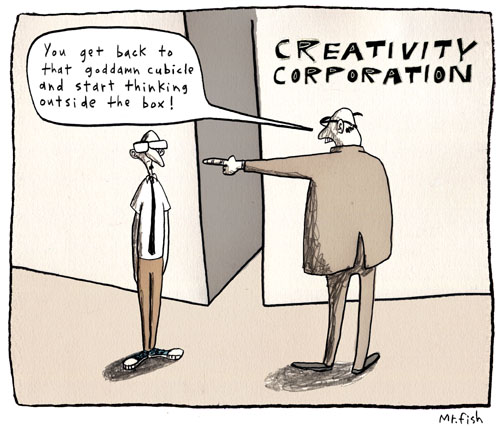Managing creativity may seem an oxymoron, similar to an order to “be spontaneous!”
Well, it doesn’t have to be. There are many methods and tools to set the stage or enhance the creativity that staff may bring to bear on daily problems or needs.
How can you stifle creativity? It’s really pretty easy…
Intellectual capital is key to creative thinking and superior results. You may be surprised at how often you may unknowingly inhibit creative problem-solving. For example, do you ever think you know what a certain colleague or team member is going to say and, as a means of attempting to demonstrate how in sync you are with that person you interrupt and complete the person’s sentence–incorrectly.
It doesn’t take too many episodes like that to shut down the other person, or at least inhibit them from correcting you—especially if you are their boss.
The additional result is the lack of recognition on your part as to what may have been an unanticipated idea with great merit–or an even better solution. And you may not realize that you have done anything wrong because no one said anything to the contrary about your interruption. The net-net result is not only inhibited communication, but also inhibited creative problem-solving, brainstorming and likely a ding in the morale of all the team members. Bad. Bad. Bad.
Beware of groupthink
Other creativity killers include the odd but powerful phenomenon called “groupthink.” This is a common problem that social psychologist Irvin Janis identified in the 1970s. It refers to the fact that many members in a group setting (like a business meeting) will look for the non-verbal cues that the understood leader (aka, the boss) may be unconsciously providing as hints to her opinion on the direction the discussion is leading. These members then conform their opinions to comply with that of the leader in order to avoid risking trouble (such as exclusion from the group, being ostracized, fired, tarred, feathered, etc.).
For example, if someone is noting his idea to a solution for a problem, the others in the meeting will be aware of their manager’s body language (posture, folded arms, nods, leaning forward or back….), facial expression (non-verbal cues) and direct feedback (verbally noting acceptance or rejection). The other members may then alter their true thoughts and feelings about what has been said by their fellow staff member in order to comply with what they perceive (or misperceive) as their manager’s impression. Since they are less likely to offer contradictory perspectives to what it is they believe the boss likes, the result is an inhibition of expressing creative ideas, and inventiveness is lost.
Stereotyping
Some people are so predictable that their responses become almost stereotypic and accurately predictable. Often this is in the negative. For example, there is the cliché of Peter “crying wolf” but sometimes there really is a wolf. And sometimes Thomas may be correct in being doubtful.
The smart manager must weigh the times when such a person is correct or better yet, create a work/team environment that supports differences in opinion with polite debate, and no discounting of anyone’s opinion.
So, what can you DO instead?
Here are a few simple tools that can yield very good results. The key with the following methods, as with any good habits, is to be consistent and to be genuine in their application.
1. Check your assumption(s) at the door. Assume nothing. Be a blank slate and thus open to ANY possibility. Do not assume you even know what the problem at hand really is. What appears to be a slump in profits may not be due to poor sales, but to distribution or production or quality or the weather. Who knows? The first step is to assume nothing and start asking OTHERS for good questions, then work to define what the problem really is and then possibilities as to causes, and finally *creative* solutions.
2. Suspend judgment. This is a corollary to No 1. No matter how left-field a person’s perspective is, respect it, seek to understand it, ask for evidence and gently, respectfully debate it if you differ with it. This supports not only a healthy diversity of opinion, but also a healthy venue for all to express themselves without worry or fear of embarrassment.
3. Put on your lab coat and help others on with theirs. Be a scientist. Look for data, clues and information on all sides of the problem or issue—those that support, contradict and appear neutral to your perspective or position on the matter. Scrutinize them with a microscope and have others do the same. Then provide an open, anxiety free ecosystem for everyone to discuss what they see and think.
4. Reframe the problem as a great opportunity–or a worse-than-reality threat. Distort reality for a bit in order to look upon the problem with a different perspective or freshness. There is another cliché that even your headache is appreciated by the pharmacist. So do look for a hidden opportunity in what at first may seem to hold little value. Pretend you are Thomas Edison and build from the knowledge of failures on your way to breakthroughs.
5. Conduct true brainstorming. Many people think that brainstorming is the simple offering of possible solutions to a given problem. This is partially correct. However, in true brainstorming, there are no ideas that are too weird, dumb, improbable, etc. Of course, people should not be cavalier in their offerings, but sometimes the cockamamie idea—while perhaps not the ultimate solution— may LEAD to the solution.
Use the brainpower of your group, staff or team to generate lots of solutions, with judgments suspended (see #2 above); sift through them later to separate the wheat from the chaff. You also may want to conclude a session of brainstorming without a resolution and ask people to think about all that has been generated in the session. Let it steep over the next few hours or days, and then later reconvene and openly discuss subsequent thoughts and ideas.
6. Rotate the devil’s advocate. While diversity of thought and opinion is good and while consensus also is good, there too is merit in debate and questioning (like that of assumptions; see #1 above). But this time, do not have the team’s resident naysayer be the person to voice the pooh-poohs. Instead, have a different person each time do so to avoid the trap of discounting the (expected negative) words based on them being said by your resident Doubting Thomas. It’s a good exercise and experience for the members of the team as well.
7. Encourage others to read outside of their field or specialty and to consider how what they read could be applied to their work. Or perhaps visit a museum, or listen to a new piece of music, or ….? You never know how exposure to something new may provide a unique spark that can catch fire to a brilliant idea.

This article is written by Dr. Chris E. Stout and reposted from his LinkedIn page.
Great tips for developing good company cultures and strategies!
bing, company, creative, creativity, culture, management, organization, tips, wedesignla

